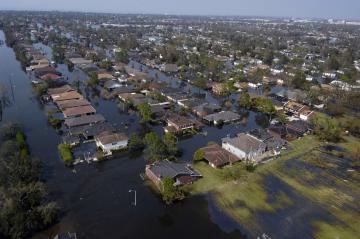The International Journal of Environmental Research and Public Health has published a Special Issue (link is external) on the inter-linkages between global contaminants and climate change. The issue was edited by Hans Sanderson, project coordinator for BASE. Climate change is expected to produce conditions that are hotter and wetter than previously experienced, with extreme weather events increasing in scale and frequency. These patterns often have far-reaching impacts on human health, which are often exacerbated by factors such as local geography, vulnerabilities in infrastructure and socioeconomic inequalities. The special issue includes contributions that range from the prevention of heat-related illness in the elderly to the impacts of climate change on mercury exposure in the Arctic.
One paper, “Climate Change and Health on the U.S. Gulf Coast: Public Health Adaptation is Needed to Address Future Risks (link is external)” by Petkova et al., provides an overview of existing evidence for present and predicted climate conditions in the US Gulf Coast and possible adaptation strategies to deal with possible health risks. The region expects increased mean temperatures – between 2.2 to 4.4°C higher over the century - as well as longer heat waves, greater rainfall and incidence of storm surges, as well as more intense hurricanes. These events lead to physical injury and loss of life, but may also precipitate a rise in vector-borne disease. Epidemiologists, for example, noted a rise in West Nile virus infections following Hurricane Katrina and norovirus among evacuees. Psychological morbidity among adults and children increases significantly following hurricanes, and mental illness and disaster-related Post-traumatic Stress Disorder (PTSD) as well as long-term physical impacts may persist for years and even decades. The Gulf Coast has furthermore seen significant population growth in the past decades, and it is home to a large number of blacks, the elderly and low-income residents – all demographic groups considered at especially high risk for climate-related health impacts.
Another case study, “Regional Projections of Extreme Apparent Temperature Days in Africa and the Related Potential Risk to Human Health (link is external)” by Garland et al., zeros in on temperature-related health impacts in particular. The paper uses regional climate modeling to project a rise in the number of days when health may be affected by increasing maximum apparent temperatures (AT) as well as the shifting of regions into more severe climate Symptom Bands. The study then correlates these results to epidemiological studies on the potential effects of high ambient temperatures on human health, which include physical disorders such as fatigue and heat stoke as well as increased mortality from cardiovascular, cerebrovascular and respiratory diseases and all-cause mortality. Adaptation measures can involve individual acclimatisation and behavioral change, but will likely require more organised heat response plans and interventions. Above all, the study highlights that climate modeling and tailoring for specific areas will help control for variability and identify “hot spots”. This will also help to increase preparedness and assist health stakeholders to identify climate services that can develop resilience in the health sector.
As these two case studies demonstrate and the other contributions in the Special Issue corroborate, climate change will put increasing stress on the natural and human environment. Mitigating these risks will require the generation of new knowledge, such as regional climate modeling and health assessments under newly emerging climate conditions, to help inform effective adaptation policies. It is also clear that there is extensive variation in health impacts depending on geography as well as demographic, socioeconomic and cultural factors. The research in this Special Issue is thus a meaningful contribution to helping health stakeholders screen adaptation options and design public health interventions.




